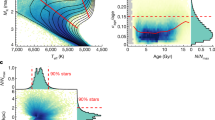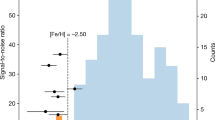Abstract
THE morphology of our Galaxy is characterized by a disk of stars moving on circular orbits, surrounding a central spheroidal body of stars on high-velocity, randomly oriented orbits. The spheroid is further differentiated into an inner bulge and an outer halo; the bulge stars are rich in elements heavier than helium ('metals'), whereas the halo stars are metal-poor, suggesting that the latter formed very early in the history of the Galaxy. (They have experienced little chemical enrichment, by previous generations of stars.) It is not known, however, whether the bulge is the inner extension of the halo, having formed as part of the same process1, or whether it formed much later, perhaps by a dynamical distortion of the inner regions of the disk2,3. Here we report observations obtained with the Hubble Space Telescope of two metal-rich globular clusters that form part of the bulge population. Within the uncertainties, these bulge globular clusters appear to be coeval with halo clusters, which suggests that the formation of the bulge was part of the dynamical process that formed the halo, and that the bulge gas underwent rapid chemical enrichment, in less than a few billion years.
This is a preview of subscription content, access via your institution
Access options
Subscribe to this journal
Receive 51 print issues and online access
$199.00 per year
only $3.90 per issue
Buy this article
- Purchase on Springer Link
- Instant access to full article PDF
Prices may be subject to local taxes which are calculated during checkout
Similar content being viewed by others
References
Eggen, O. J., Lynden-Bell, D. & Sandage, A. Astrophys. J. 136, 748–766 (1962).
Raha, N., Sellwood, J. A., James, R. A. & Kahn, F. D. Nature 352, 411–412 (1991).
Pfenniger, D. & Friedli, D. Astr. Astrophys. 252, 75–93 (1991).
Larson, R. B. Mon. Not. R. astr. Soc. 173, 671–699 (1975).
Renzini, A. & Greggio, L. in Bulges of Galaxies 47–63 (eds Jarvis, B. J. & Terndrup, D. M.) (Conf. & Workshop Ser. 35, ESO, Garching, 1990).
Larson, R. B. Publs astr. Soc. Pacif. 102, 709–722 (1990).
Lee, Y.-W. Astr. J. 104, 1780–1789 (1992).
Renzini, A. in Galactic Bulges 151–168 (eds Dejonghe, H. & Habing, H. J.) (IAU Symp. 153, Kluwer, Dordrecht, 1993).
Rich, R. M. Mem. Soc. Astr. It. 56, 23–35 (1985).
Frogel, J. A. A. Rev. Astr. Astrophys. 26, 51–92 (1988).
Terndrup, D. M. Astr. J. 96, 884–908 (1988).
Whitelock, P., Feast, M. & Catchpole, R. Mon. Not. R. astr. Soc. 248, 276–312 (1991).
Holzman, J. A. et al. Astr. J. 106, 1826–1838 (1993).
Paczyński, B. et al. Astr. J. 107, 2060–2066 (1994).
Renzini, A. Astr. Astrophys. 285, L5–L8 (1994).
Zinn, R. Astropnys. J. 293, 424–444 (1985).
Barbuy, B., Castro, S., Ortolani, S. & Bica, E. Astr. Astrophys. 259, 607–613 (1992).
Cohen, J. G. & Sleeper, C. Astr. J. 109, 242–263 (1995).
McWilliam, A. & Rich, R. M. Astrophys. J. Suppl. Ser. 91, 749–791 (1994).
Hesser, J. E., Shawl, S. J. & Meyer, J. E. Publs Astr. Soc. Pacif. 98, 403–422 (1986).
Minniti, D. Astr. J. 109, 1663–1669 (1995).
Renzini, A. in Observational Tests of Cosmological Inflation 131–146 (eds Shanks, T. et al.) (Kluwer, Dordrecht, 1991).
Garnavich, P. M., VandenBerg, D. A., Zurek, D. R. & Hesser, J. E. Astr. J. 107, 1097–1110 (1994).
Sandage, A. & Cacciari, C. Astrophys. J. 350, 645–661 (1990).
Walker, A. R. Astrophys. J. 390, L81–L84 (1992).
Carney, B. Mem. Soc. Astr. It. 63, 409–431 (1992).
Stetson, P. Publs Astr. Soc. Pacif. 99, 191–222 (1987).
Sellwood, J. & Sanders, R. Mon. Not. R. astr. Soc. 233, 611–620 (1988).
Author information
Authors and Affiliations
Rights and permissions
About this article
Cite this article
Ortolani, S., Renzini, ., Gilmozzi, R. et al. Near-coeval formation of the Galactic bulge and halo inferred from globular cluster ages. Nature 377, 701–704 (1995). https://doi.org/10.1038/377701a0
Received:
Accepted:
Issue Date:
DOI: https://doi.org/10.1038/377701a0
This article is cited by
-
Impact of Distance Determinations on Galactic Structure. II. Old Tracers
Space Science Reviews (2018)
-
Horizontal branch stars: the interplay between observations and theory, and insights into the formation of the Galaxy
Astrophysics and Space Science (2009)
Comments
By submitting a comment you agree to abide by our Terms and Community Guidelines. If you find something abusive or that does not comply with our terms or guidelines please flag it as inappropriate.



